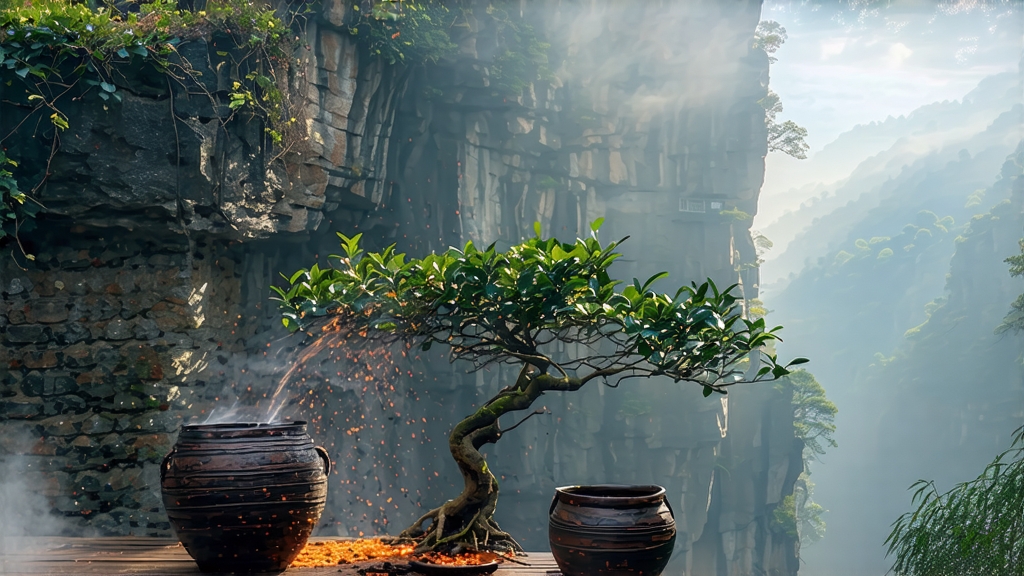
Few leaves have inspired as many legends, court poems, and modern auction records as Da Hong Pao, the “Big Red Robe” that grows on the sheer cliffs of northern Fujian’s Wuyi Mountains. To the Chinese palate it is the benchmark of yan yun—“rock rhyme”—a mineral cadence that lingers like the aftertaste of a river stone kissed by mist. To the global tea traveler it is a living bridge between Song-dynasty court culture, Ming-era innovation, and twenty-first-century sustainability experiments. This essay invites you to walk that bridge, from the mythic origin story of a Ming emperor who draped his scarlet cloak over six mother trees to the microscopic science that explains why a single gram can fetch thousands of dollars. We will explore how three sub-varietals (Qi Dan, Bei Dou, and Que She) diverged from those original bushes, how a 24-hour “green ribbon” withering on 400-meter cliffs is followed by midnight charcoal roasting in bamboo baskets, and why a 95 °C flash infusion in a 120 ml gaiwan can coax out flavors that remind some of toasted cashew, others of midnight orchid, and still others of the very granite on which the roots cling.
-
Myth and Documented History
Local gazetteers first mention “red robe tea” in 1385, when a Ming scholar recovered from fever after drinking an infusion plucked from the Wuyi Tianxin Rock. In gratitude the emperor sent officers to drape the bushes in crimson silk, an honor normally reserved for victorious generals. By the early Qing the tea had become tribute, carried across the Mei-ling Pass on horseback and rafted down the Yangtze to Beijing. When the six mother trees—now protected by UNESCO and monitored with motion sensors—were last harvested in 2006, 20 g of leaves sold for USD 28,000, an event that paradoxically accelerated clonal propagation rather than curtailing consumption. Today more than 4,000 hectares of Wuyi’s core scenic zone are planted with direct or first-generation descendants, yet only 60 hectares lie inside the original 36 peaks and 99 valleys that qualify for the coveted “zheng yan” (true cliff) designation. -
Micro-Terroir: Why Cliffs Taste Different
Wuyi’s Danxia landform compresses 400 million years of sandstone and tuff into knife-edge ridges that rise 200–500 m above the Jiuqu (Nine-Bend) Stream. Daytime reflected light and nocturnal radiative cooling create a 10 °C diurnal swing, forcing the leaves to thicken their cell walls and concentrate aromatic precursors such as geraniol and β-ionone. Meanwhile, short-wave ultraviolet filtered through perennial fog elevates amino acids, especially theanine, which buffers the astringency of polyphenols and delivers the famous “sweet return” (hui gan). The same cliffs host 3,600 plant species; their fallen leaves compost into a humus so thin that farmers joke a spade would “hit the rock’s shoulder.” This starvation stress lowers yield to 180 kg per hectare—one-tenth of a flat-land oolong—but concentrates flavor to an almost synesthetic intensity. -
Varietal Lineage: Qi Dan, Bei Dou, Que She
Genetic fingerprinting at the Chinese Academy of Agricultural Sciences shows 99.2 % SSR similarity between the mother trees and Qi Dan, making it the closest commercially available approximation. Bei Dou (“North Star”) was grafted in 1985 from cuttings taken at 3 a.m. under a new moon, a timing believed to preserve “yin energy.” Que She (“Sparrow Tongue”) is a natural dwarf mutant with leaves only 5 cm long, yielding a liquor that is paler yet more persistently floral. All three are harvested in the brief spring window between Grain Rain and Start of Summer, when two leaves and a bud reach the “small open face” stage, still soft enough to fold without snapping. -
Craft: The Green Ribbon and the Charcoal Cave
At dawn pickers carry bamboo baskets up goat paths; by 9 a.m. the leaves are spread on water-permeable bamboo mats 2 m above the ground, allowing mountain updrafts to wither them for 6–8 h. Hand tossing every 20 min bruises the edges just enough to initiate oxidation while keeping the center green—what locals call the “green ribbon red edge” aesthetic. Once the